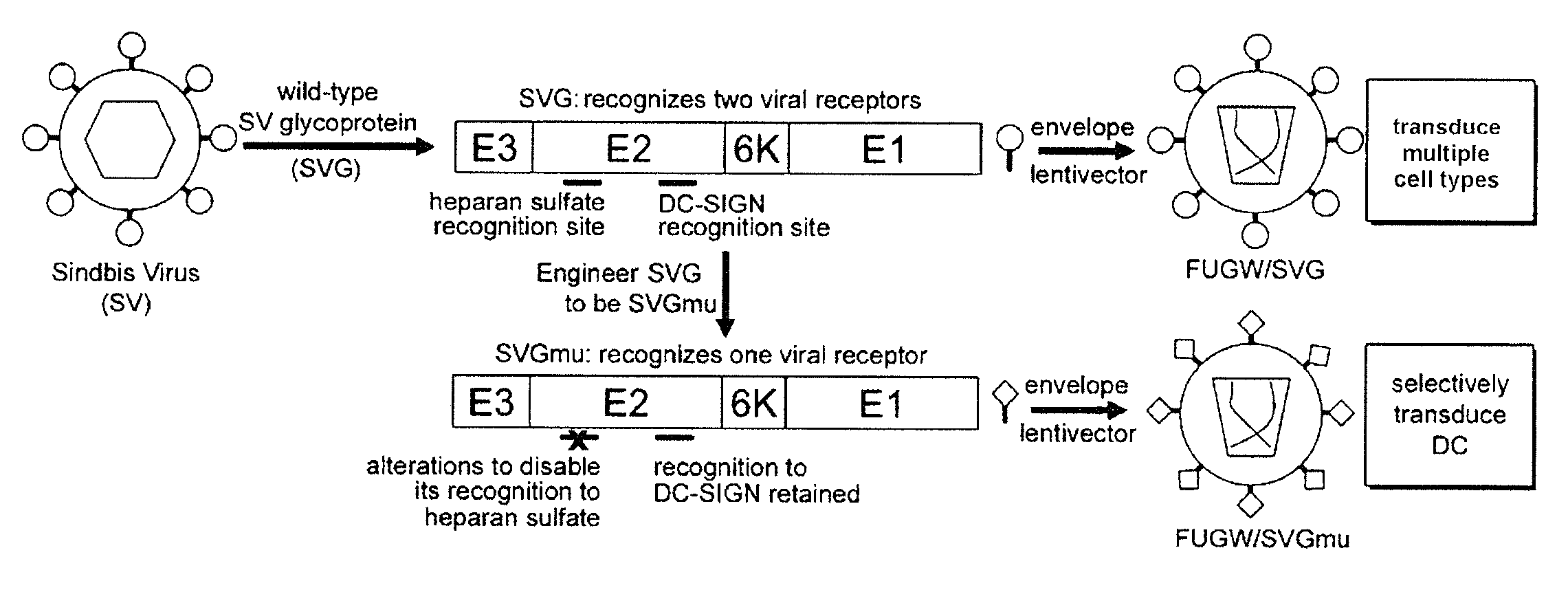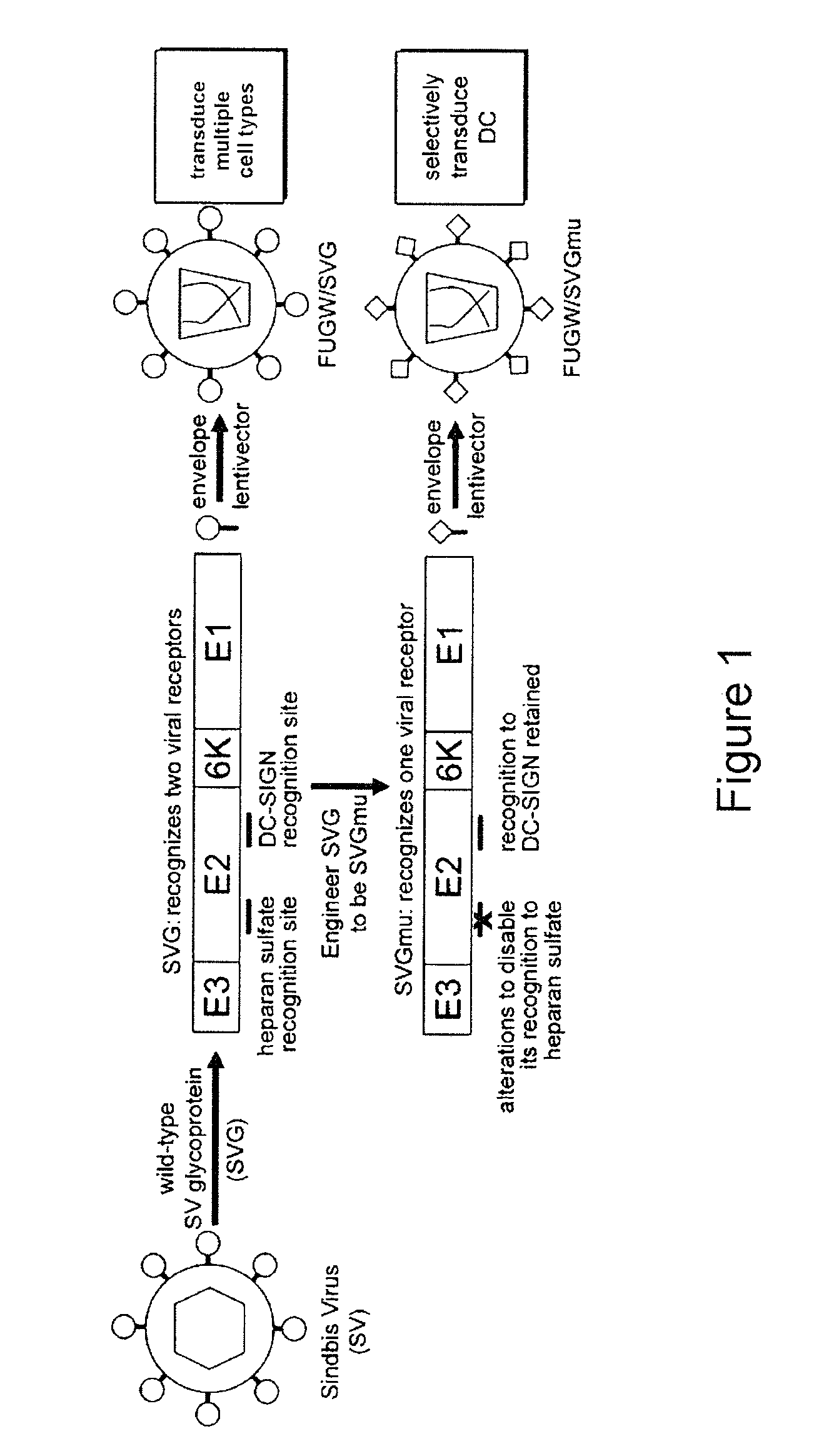Targeted gene delivery for dendritic cell vaccination
a dendritic cell and gene technology, applied in the field of targeted gene delivery, can solve the problems of inconvenient ex vivo generation of dendritic cells for each patient, remains burdened by limitations, and laborious process of ex vivo generation of dendritic cells
- Summary
- Abstract
- Description
- Claims
- Application Information
AI Technical Summary
Problems solved by technology
Method used
Image
Examples
example 1
Engineering of a DC-Specific Targeting Molecule
[0228]Lentiviral vectors can be rationally engineered to make them capable of transducing DCs in a cell-specific manner. Certain subsets of DCs bear on their surface the DC-SIGN protein (Geijtenbeek, T. B., et al. 2000; Geijtenbeek, T. B., et al. 2000, supra), a C-type lectin-like receptor capable of rapid binding and endocytosis of materials (Geijtenbeek, T. B., et al. 2004, supra.), which can be used as a targeting receptor on DCs. Sindbis virus (SV)—a member of the Alphavirus genus and the Togaviridae family—is able to infect DCs through DC-SIGN (Klimstra, W. B., et al. 2003. J. Virol. 77: 12022-12032, which is incorporated herein by reference in its entirety). However, the canonical viral receptor for the laboratory strain of SV is cell-surface heparan sulfate (HS), which is expressed by many cell types (Strauss, J. H., et al. 1994. Arch. Virol. 9: 473-484; Byrnes, A. P., and D. E. Griffin. 1998. J. Virol. 72: 7349-7356, each of whi...
example 2
Preparation of Recombinant Virus Containing the DC-Specific Targeting Molecule
[0231]Preparation of the recombinant SVGmu-pseudotyped lentivirus was conducted by standard calcium phosphate-mediated transient transfection of 293T cells with the lentiviral vector FUGW (SEQ ID NO:1) or its derivatives, the packaging constructs encoding gag, pol and rev genes, and pSVGmu (Example 1). FUGW is a self-inactivating lentiviral vector carrying the human ubiquitin-C promoter to drive the expression of a GFP reporter gene (Lois, C., et al. 2002. Science 295: 868-872, which is incorporated herein by reference in its entirety). The lentiviral transfer vectors (FUGW and its derivatives) used in these studies are third generation HIV-based lentiviral vectors, in which most of the U3 region of the 3′ LTR is deleted, resulting in a self-inactivating 3′-LTR (SIN).
[0232]For the transient transfection of 293T cells, 293T cells cultured in 6-cm tissue culture dishes (Coming or BD Biosciences) were transfe...
example 3
Confocal Imaging of Packaged Recombinant Virus
[0234]GFP-vpr-labeled lentivectors were produced as described in Example 2, except with use of FUW lentivector (which does not contain the GFP reporter gene) and with a separate plasmid encoding GFP-vpr (2.5 μg). Fresh viral supernatant was overlaid on polylysine-coated coverslips in a 6-well culture dish and centrifuged at 3,700×g at 4° C. for 2 hours using a Sorvall Legend RT centrifuge. The coverslips were rinsed with cold PBS twice and immunostained by anti-HA-biotin antibody (Miltenyi Biotec) and Cy5-streptavidin (Invitrogen). Fluorescent images were taken by a Zeiss LSM 510 laser scanning confocal microscope equipped with filter sets for fluorescein and Cy5. A plan-apochromat oil immersion objective (63× / 1.4) was used for imaging.
[0235]FIG. 2 shows the results of the confocal imaging of the recombinant virus produced by the protocol. (The scale bar represents 2 μm.) Particles in the “GFP” slide are stained green, particles in the “...
PUM
| Property | Measurement | Unit |
|---|---|---|
| concentration | aaaaa | aaaaa |
| size | aaaaa | aaaaa |
| Intracellular Adhesion | aaaaa | aaaaa |
Abstract
Description
Claims
Application Information
 Login to View More
Login to View More - R&D
- Intellectual Property
- Life Sciences
- Materials
- Tech Scout
- Unparalleled Data Quality
- Higher Quality Content
- 60% Fewer Hallucinations
Browse by: Latest US Patents, China's latest patents, Technical Efficacy Thesaurus, Application Domain, Technology Topic, Popular Technical Reports.
© 2025 PatSnap. All rights reserved.Legal|Privacy policy|Modern Slavery Act Transparency Statement|Sitemap|About US| Contact US: help@patsnap.com



